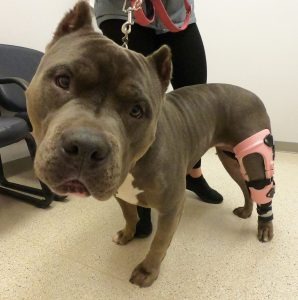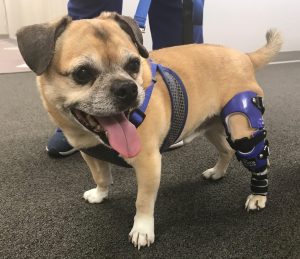
Clayton Blunk
Clinical Practitioner
CCL Injury Overview
Over the past 15 years, My Pet’s Brace in Morgantown, PA, has been providing custom animal orthotics for dogs all over the world. I have been with the company for over ten years and have developed a deep understanding of my role in helping your patients. I wanted to reflect on lessons learned on what makes a “good” brace candidate for the treatment of a dog leg injury.
Around 85% of our patients are seen for Cranial Cruciate Ligament (CCL) injuries, also known as ACL tears in humans. As the surgical approaches evolve, so do the conservative treatment options for a dog’s CCL tear and clients wanting to seek out safe, effective, and affordable treatments for their dog’s leg injury.
How A Knee Brace Works
The knee brace allows the dog to bear more weight on the injured leg and provides comfort through range of motion. The anterior knee strap puts pressure on the tibial crest to help prevent cranial drawer motion. Over time, the support of the brace and prevention of the drawer motion helps develop stable scar tissue. Dogs gradually return to their normal activity and the muscle mass is restored.
In our experience, most dogs need to wear their knee brace for 6-9 months for good, strong scar tissue to develop. Pet families can start going for short, leashed walks on the very first day with the brace. For the first three months, it’s recommended that activity be restricted to leashed walks, with no crazy running or ball playing.
The brace as treatment for this dog leg injury is typically used in place of surgery, but a brace can also be used post-surgically to provide additional support to the leg, especially for active or giant breed dogs.
To Brace or Not to Brace?
Learn when a brace is or is not an appropriate part of your patient’s CCL leg injury rehabilitative treatment plan.
Ideal Candidates
In my opinion and from what I have observed clinically, many dogs benefit from a brace as treatment for a leg injury. Our most common dogs are senior dogs. They are still active, but clients do not want to put their dogs through surgery. I typically see dogs who received a surgical procedure years ago and recovered well, but clients do not want to put their dogs through another invasive procedure and prefer conservative treatment without surgery for their dog’s CCL tear.
I also see plenty of dogs with concurrent health issues that make them a surgical risk. If there is a concern about anesthesia, a more difficult than average surgical recovery, or a higher infection risk, a brace may be a viable treatment option.
Some clients are very concerned with the surgical recovery period. Using the brace as treatment for the dog’s leg injury requires a longer timeframe, but is “easier” in some respects. Clients may have a busy household with young children, or lots of other animals to care for. I think the risks of mismanaging the surgical recovery are high. The brace makes these “management errors” a bump in the road rather than having to come back for a surgical revision.
Along the same lines, some clients want to avoid surgery at all costs—or at least not without trying conservative management as treatment for their dog’s leg injury first. To me, this parallels the progression of care in human orthopedics for an ACL tear; management, lifestyle changes, and physical therapy before a surgical procedure.
There are also dogs, young and old, that deal with varying levels of separation and/or confinement anxiety. Crate/room rest for those dogs can inadvertently cause more problems. Also, think of the dogs we have all seen that have never been on a leash before or given any sort of “rules” at home. Asking those dogs or owners to go right to crate rest post-surgery is likely not going to go well.
Challenging Candidates
I wanted to share some types of dogs or conditions that can be more challenging.
Junk in the trunk
Overweight dogs can be a challenge to fit with a brace. None of us enjoy the “weight conversation” but if a dog has excessive fat on their hind end or a hanging belly, it sometimes makes it physically impossible to fabricate a brace to suspend on the leg. Often the best way forward is a serious discussion about weight loss before using a brace as a successful treatment for the dog’s leg injury. It is sometimes a beneficial and necessary “reality check” that gets clients on board with weight loss. Along the same lines, pot-bellied dogs can have a hard time getting comfortable with a brace. Their bellies can push the brace down and make it frustrating to use.
Teeny Tiny
On the other end of the spectrum, very small dogs can be difficult to brace. Our parts can only be made so small, and the hinges/joints we use sometimes are just too big for a tiny dog. Dogs that are under seven pounds are usually too small for custom knee braces.
Confirmation
As I mentioned earlier, certain breeds/types of dogs can be challenging to help using bracing as a conservative treatment without surgery for dog CCL tears. We are constantly challenging ourselves to find out how we can be more successful, but sometimes we simply cannot make a brace for certain dogs.
Bulldogs or any short, stocky breed can be a real challenge. They tend to have very straight stifles and hocks, and our braces depend on some angle in the hock to suspend. We have made some great strides over the years with different designs based on confirmation. It is a continually improving process.
Heavy and muscular dogs can potentially have challenges with suspension. The muscles in the hamstring and quads fire and can push and pull the brace. Sometimes the brace cannot move with the muscles well enough to maintain a proper fit.
Corgis and Doxies can also be hard to brace. Their thighs are so wide compared to how short the legs are that there may not be room to hold a brace in place.
What’s the Plan?
I don’t want any of the above to stop you from considering a brace as treatment for a dog’s leg injury. If you are unsure if your client is a good candidate for a brace, just take a few minutes to snap some photos or take some videos to send to us. It will help us determine if they are a candidate and guide our decision-making when fabricating the brace.
If your patient is a candidate for a brace, what do you do now? Custom bracing requires a fiberglass mold of the injured leg, accompanied by diagnostic information and some measurements. This process is very important as the quality of the cast impacts the quality of the final brace fit and function. Patients can come directly to one of our facilities for the casting process at no additional cost to the client, or you can make a mold at your office to send to us for fabrication. If you are taking the cast of the dog’s leg, please watch our training videos on our website to see what we require for an appropriate cast.
We make every brace by hand at our facility in Morgantown, PA. It takes a week to fabricate a brace. You will receive the brace in the mail, backed by a no-hassle warranty. We can assist with any troubleshooting or questions you have.
Closing Thoughts
The use of a custom brace for your client’s CCL injury is a great alternative to surgery. You may have clients who have concurrent health issues where surgery is not a good option. Additionally, your clients may not have the means to afford surgery. It is best to give clients options so they can make an informed decision for their pet’s health.
If you have any questions or concerns, or if you want to speak to one of our experts, please reach out to us.


